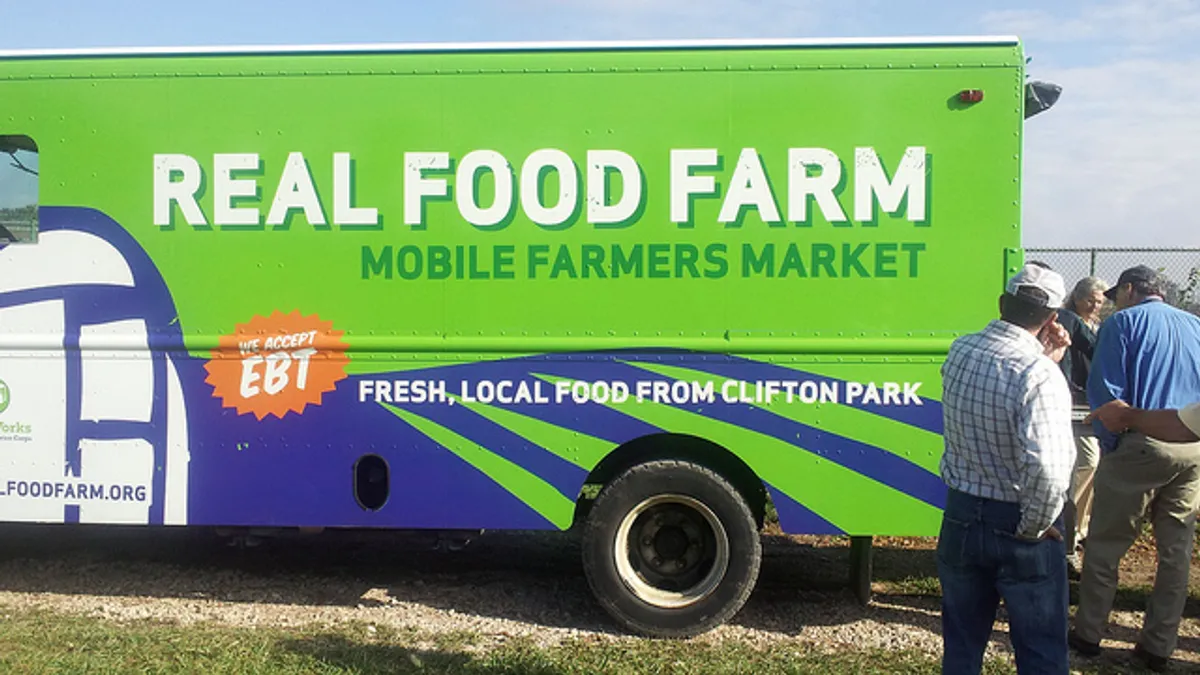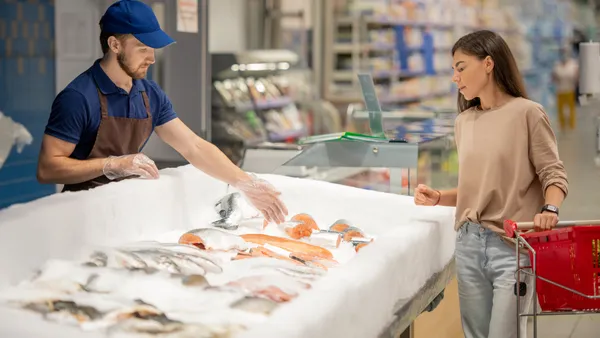Dive Brief:
- Kroger's subsidiary Pick'n'Save and the Hunger Task Force will bring their Fresh Picks Mobile Market to the Louisville area in partnership with Louisville Forward, the city's economic development arm that invested $60,000 in the project, according to The Courier-Journal reported. The mobile food trucks will soon traverse the streets of Louisville to bring fresh produce, meat and other groceries to residents without easy access to healthy food.
- The mobile market has operated in the Milwaukee area since 2015 and has served 30 to 40 people per stop. Converted from a standard semi-trailer, both climate-controlled trucks offer a single shopping aisle and accept debit or credit cards as well as EBT cards issued through SNAP, as stated in The Courier-Journal.
- Dare to Care food bank distributed 24 million pounds of food to Kentuckians last year, but the mobile market allows people who can afford food but lack access a chance to shop for themselves, the nonprofits executive director told the newspaper. While Kroger provides two associates to manage and place orders, the food bank enlists community leaders to organize stops and volunteers.
Dive Insight:
About 44,000 people in Louisville live in food deserts, defined by the USDA as typically low-income areas without unimpeded access to healthy, affordable food. The affordable aspect remains central to Kroger's mobile markets, which sell food at similar prices to their brick-and-mortar stores.
For the nearly 24 million Americans living in food deserts — or those who are considered to be food insecure — getting to the nearest grocery store can be a burden, especially without reliable transportation. About a third of SNAP recipients borrow a car, take public transportation or walk to the supermarket, compared to less than 20% of middle- and high-income households, according to a USDA and Economic Research Service study.
Mobile markets in Chicago, Oakland, California, (one of the first mobile markets, according to Asparagus Magazine) and Baltimore have attempted to bridge the food access gap. As a virtual market, the Baltimore model beckons a techier future, allowing customers to order groceries online for pickup at libraries, schools and senior housing sites in their neighborhood. New York City sponsors Green Carts, which look similar to the city's famed street food vendors but stock produce. In Indian Country, mobile markets have also attempted to help residents gain access to healthy foods, per the Partnership with Native Americans.
Without a partner like Kroger, however, many of these well-intended ideas have been developed and funded by city governments and nonprofit organizations, which can't sustain the low-margin realities of the grocery business. As Fast Company reported about Toronto's mobile markets in 2014, the model doesn't make sound financial sense. A truck's footprint pales in comparison to even a neighborhood grocery store, and only a few people can shop at a time. Second, timing — and awareness — is everything.
Some mobile markets have evolved into community-supported markets, perhaps aided by donations from grocery sponsors and nonprofits. At their core, farmers markets are mobile markets, and many accept SNAP thanks to philanthropic support, in some cases state funding and in recent years a small pot from the federal government as well. Across the country, farmers markets also offer double-bucks programs for SNAP users to buy fresh fruits and vegetables, and those programs have by and large been a success.
Mobile trucks might be a short-term solution, but they are steps in a positive direction to ensure everyone has access to and can afford healthy food. Where government-sponsored programs might fall short, retailers have the resources and know-how to give 50 million food-insecure Americans, including 12 million children, access to healthy, affordable foods.












